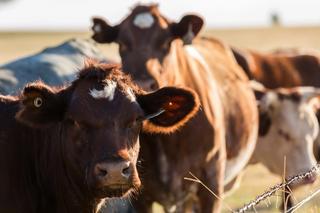Avian Flu Updates: Latest News
Protect Your Poultry From Avian Flu Using Biosecurity


Bird flu is back, and for the first time, it has been found in dairy cows and for just the second time, it has been transmitted to a human.
Texas agricultural officials reported in March that a person had been infected with bird flu after coming into close contact with infected dairy cows in Texas.
The Texas Department of State Health Services (DSHS) reported that the patient became ill following contact with dairy cows presumed to be infected with avian influenza, with the patient’s primary symptom being conjunctivitis, also known as pink eye.
Virus Jumped to Cattle for the First Time
The discovery marks the first time bird flu has been found in dairy cattle, the American Veterinary Medical Association said, and the findings came just days after the virus was detected in goats on a farm in Minnesota as well as in herds in New Mexico, Michigan and Idaho that had recently received cows from Texas.
In an announcement from the CDC, officials said that it is the first human case of the highly pathogenic strain of avian influenza (HPAI) in the state of Texas and the second overall in the U.S. It is believed to have been transmitted from a wild bird to a dairy cow, then to a human.
The CDC said its officials, along with the Food and Drug Administration (FDA) and the state veterinary and public health authorities, are investigating the illness, which was first detected primarily in older dairy cows. The highly contagious virus was found in unpasteurized clinical samples of milk from cows at two dairy farms in Kansas and one in Texas.
Eggs Are Going to Get Expensive, Again
Just days after the news of the virus appearing in dairy cows broke, Cal-Maine Foods, Inc., the nation’s largest producer and distributor of fresh eggs, announced the discovery of HPAI at its Parmer County, Texas, facility earlier this week. The outbreak has resulted in the loss of 1.6 million laying hens and 337,000 pullets, which the company said was about 4% of its entire flock.
However, the CDC points out that, unlike poultry infections, which are fatal, sick dairy cows tend to recover on their own. Officials also said it’s safe to drink milk since it’s pasteurized before being sold, although milk from sick animals is being destroyed so that it does not enter the food supply.
“There are thousands of people, from veterinarians to researchers across the country, who are actively and diligently looking for these types of pathogens every single day,” Dr. Sergio Arispe, a professor at Oregon State University, specializing in herd management, told Farmers Hot Line. “It’s a testament to the vast safety networks in place to catch this type of thing, and catch it early.”
Bird Flu Is Spreading Rapidly
The scope of the current outbreak is part of a larger global trend of bird flu epidemics since 2020. The virus, at first initially only found in birds, has displayed an alarming ability for zoonotic transmission and has been found on every continent in everything from penguins, dolphins, skunks, squirrels, polar bears, horses, and now, humans and dairy cows.
Since its emergence in 1996, bird flu has shown remarkable resilience and has recently begun to decimate non-bird populations. One of the most alarming discoveries was made in Argentina late last year, when the carrion of thousands of South American sea lions and elephant seals littered the Valdés Peninsula after succumbing to the virus; decimating more than 95% of the colony’s young, the New York Times reported.
Fear Goes Viral
The CDC issued guidance emphasizing, first, the safety of our dairy and beef food supply, adding that the pathogen has not been found, as of yet, to be able to pass through the food chain and is very rarely transmitted human to human.
The virus has now been confirmed in eight states, and while it has not been detected in beef cattle (yet), the fear has already seeped into the beef market. Bloomberg reported on April 1 that selling intensified after the news of a human case broke. Live cattle futures for June closed down $4.925 to $175.325, while April futures dropped $4.925 to $180.07, with May feeder cattle futures plunging $6.025 to $242.67.
As soon as the words “bird flu” are heard, hysteria isn’t far behind. Experts are stressing the importance of following the protocols already well in place for these types of discoveries. Monitor and report all cases of any illness in both humans and animals and closely observe individuals and animals who have been in contact with infected animals.
Symptoms in humans are typical of a garden-variety flu; fever, cough, sore throat, muscle aches and in severe cases, pneumonia, respiratory distress and conjunctivitis. In cows, symptoms can manifest as respiratory issues, listlessness and a noticeable change in milk appearance, texture along with a sudden decrease in milk production.
Arispe stressed the single most important aspect after any virus detection on this scale is free and unsalted communication between everyone from ranch hands to state officials and even from bird enthusiasts.
“Finding and identifying these pathogens as quickly as possible really does take a village,” Dr. Arispe added. “Veterinarians, ranchers, government authorities, even Birders, bring a useful and unique set of skills that are all harnessed to enhance disease surveillance and early identification efforts.”
The CDC recommends several measures for ranchers to help prevent the spread of bird flu to cows, such as biosecurity practices, constant testing and collaboration with state agricultural authorities.
The state department of health also issued a health alert to healthcare providers to be vigilant about these symptoms, especially among those who have regular contact with animals.
Bird flu is a disease caused by a family of flu viruses primarily transmitted among birds.
The CDC and USDA classify avian influenza viruses into two groups: low pathogenic avian influenza (often seen in wild birds) and HPAI, found mostly in domestic poultry.
Media reports say bird flu has cost the U.S. government around $2 billion over the past two years, with nearly 60 million birds destroyed, sending the price of eggs and poultry through the roof about two years ago.
Healthcare providers have also been advised to immediately consult their local health department if they come across patients who are experiencing symptoms and have come into close contact with livestock and cattle.
Infected Poultry Can Spread Bird Flu to People
Biosecurity is critical in preventing the spread of diseases within agricultural operations, particularly in poultry farms. It involves implementing measures that limit the entry and spread of infectious agents into animal populations. This includes practices like maintaining a clean environment through regular disinfection, isolating new or returning animals and monitoring animal health closely. Effective biosecurity safeguards not only the health and well-being of the animals but also protects public health.
According to the Washington State Department of Health, there are biosecurity practices for backyard chicken keepers. To maintain a healthy poultry environment on your homestead, adhere to the following guidelines:
Limit Bird Exposure: Allow only caregivers to interact with your poultry, minimizing contact with visitors.
Wildlife Exclusion: Protect your birds from wild animals by securing their habitat with overhead coverings.
Maintain Cleanliness: Use outdoor sinks or hoses to clean shoes, tools, and equipment, preventing germ spread.
Quarantine New Arrivals: To prevent disease transmission, isolate new or returning birds for specific periods (30 days for new birds, two weeks for those from fairs/exhibits).
Avoid Equipment Sharing: Do not share poultry tools and equipment with neighbors to reduce disease risk.
Monitor Health Signs: Stay vigilant for symptoms of illness in birds, such as sneezing, coughing, nasal discharge, diarrhea, decreased energy, reduced appetite, lower egg production, or sudden death.
Report Illnesses: If you notice unusual health issues or bird deaths, contact the Avian Health Program at 1-800-606-3056 and consult a local veterinarian promptly.
Following these steps can significantly reduce the risk of disease in your poultry flock.
Update: Three new cases were reported.
Tags:Poultry Advancements

Chicken Whisperer is part of the Catalyst Communications Network publication family.












